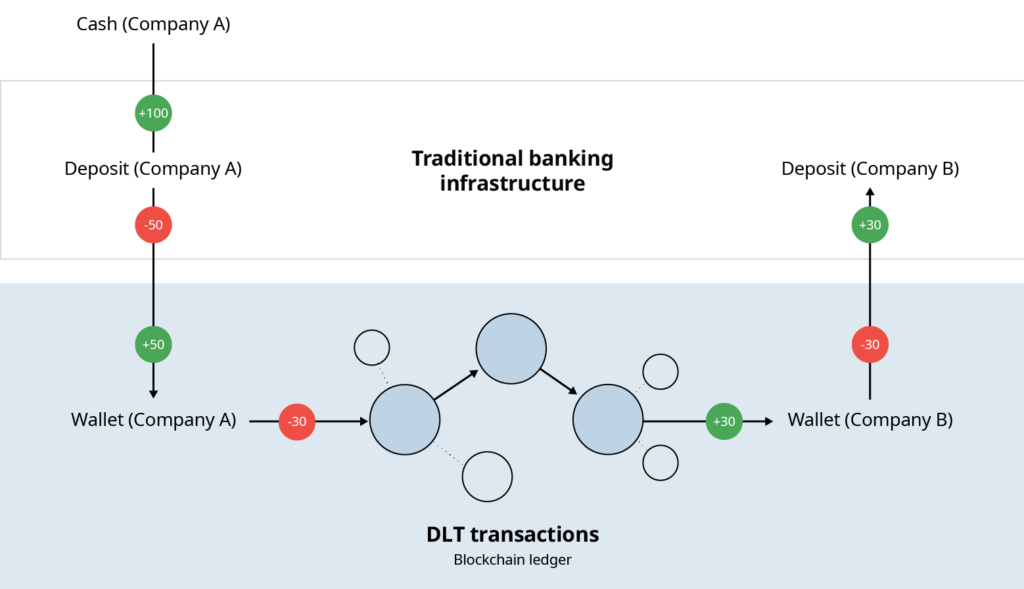
Main Points:
- VersaBank launches a tokenized deposit pilot program (USDVB) in the U.S., offering FDIC-insured, interest-bearing digital tokens backed 1:1 by actual dollars.
- USDVBs run on Ethereum, Algorand, and Stellar, managed through VersaVault and VersaView platforms.
- The initiative focuses on regulatory compliance—targeting OCC non‑objection—and positions these tokens as safer alternatives to stablecoins.
- The pilot demonstrates banking-grade security, scalability, and programmability for real-world financial applications.
- Success goals include expanding digital banking services, reducing costs, and enabling institutional adoption of blockchain-based deposits.
Introduction
VersaBank, a Canadian digital bank known for its technology-driven, business-focused banking operations, has launched a groundbreaking pilot in the United States that tests a bank-issued tokenized deposit called USDVB. Each USDVB represents a one-to-one claim on a U.S. dollar held in deposit with VersaBank USA—offering the security of FDIC insurance, the ability to earn interest, and the efficiency of blockchain-based transactions.

What is the USDVB Pilot?
Digital Deposit Receipts (DDRs) in Action
VersaBank’s proprietary Digital Deposit Receipts (DDRs), branded USDVB for U.S. dollars, are encrypted, tokenized representations of actual cash held at VersaBank USA. Just like traditional deposit certificates, USDVBs are liabilities on the bank’s balance sheet, but they live on a blockchain—enabling programmable and instantaneous financial operations.
Secure, Regulated, and Interest-Bearing
Unlike typical stablecoins issued by private firms backed by reserves, USDVBs are issued by a regulated, federally chartered bank, come with FDIC insurance, and legally allow interest payouts. They are crafted to align with stringent frameworks such as SOC 2 Type 1, BSA, and OFAC compliance.
Blockchain Infrastructure & Token Management
The pilot spans three public permissionless blockchains—Ethereum, Algorand, and Stellar. Tokens are issued through the VersaVault digital vault system and accessed via the VersaView e-wallet interface, enabling secure issuance, redemption, and on-chain management.
Pilot Design & Objectives
Phased Testing with Partners
VersaBank is conducting thousands of small transactions in phases: starting internally, then expanding to selected external partners. This staged rollout verifies performance, scalability, and regulatory alignment before a broader release.
Regulatory Path to Commercialization
A critical milestone is obtaining a “non‑objection” from the Office of the Comptroller of the Currency (OCC). VersaBank plans to complete the pilot by the end of 2025, then move toward a commercial launch pending regulatory green light.
Why USDVBs Stand Out in the Digital Asset Landscape
Differentiation from Stablecoins
While stablecoins like USDC or USDT have dominated the crypto narrative, they often face criticism for non-transparent reserves and regulatory uncertainty. In contrast, USDVBs are issued by a regulated bank, backed by actual cash reserves, carry FDIC insurance, and can earn interest—all within a compliant framework.
Institutional-Grade Innovation
The pilot emphasizes institutional trust, leveraging encryption standards and compliance frameworks familiar to banks and regulators. This positioning appeals to institutional clients and provides a scalable blueprint for blockchain deployment in mainstream finance.
Financial and Strategic Implications
Tokenized deposits could significantly reduce transaction costs, improve liquidity, and facilitate programmable money applications like cross-border payments, smart contracts, and DeFi integration—all with the safety net of traditional banking structures.
Broader Industry Context
Emerging Trend Among Banks
VersaBank follows earlier experiments: Custodia Bank and Vantage Bank tokenized dollar deposits on Ethereum, and JPMorgan tested a token on Coinbase’s Base network. This signals a broader shift among banks exploring blockchain rails for efficiency and control, in contrast to private stablecoin issuers .
Digital Banking Expansion
With $3.5 billion in assets, VersaBank is using USDVBs as potentially low-cost funding sources and strategic enablers for partnerships with payment providers, fintechs, and other banks looking to leverage tokenized efficiencies without regulatory risk.
Summary and Outlook
VersaBank’s USDVB pilot is a strategic leap toward harmonizing traditional banking with blockchain innovation. By offering FDIC-insured, interest-bearing, bank-issued tokens on multiple public blockchains, VersaBank is not merely experimenting—it’s designing the future of digital banking.
Its first-mover advantage and regulatory-first approach could pave the way for widespread institutional adoption, offering a trusted and programmable alternative to existing stablecoins. The success of this pilot may influence how banks, fintechs, and regulators shape the integration of digital assets into mainstream finance.

